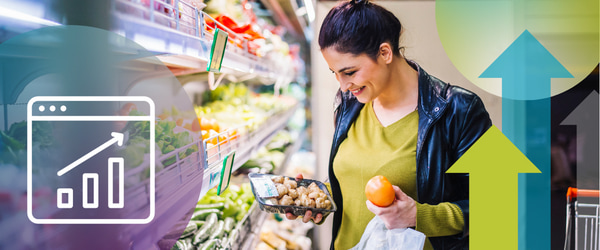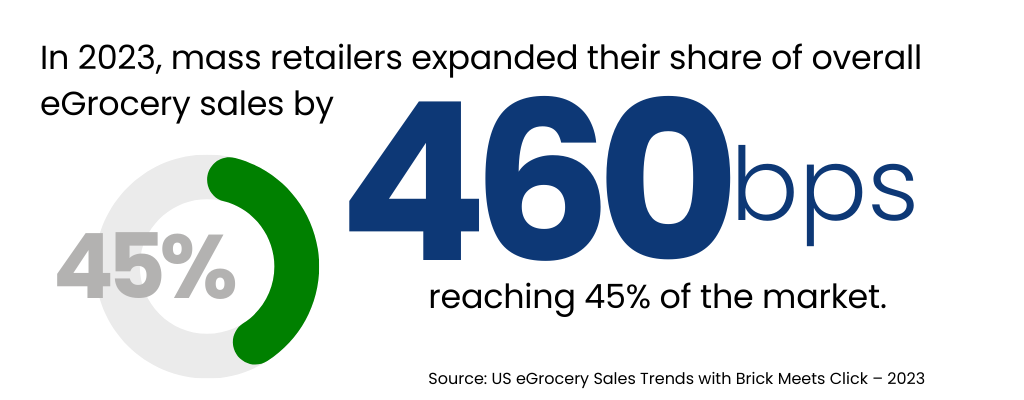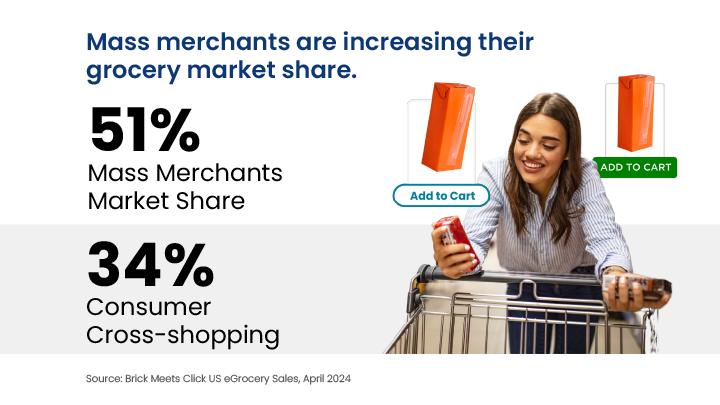Introduction
Grocery loyalty programs have become a valuable tool for driving customer engagement and retaining a loyal customer base. Unlike traditional loyalty initiatives that merely offer generic discounts or rewards, modern grocery loyalty programs must evolve to meet the sophisticated needs of today’s consumers. These programs are no longer just about incentivizing repeat purchases; they are about creating personalized, meaningful experiences that resonate with customers on a deeper level.
The importance of grocery loyalty programs lies in fostering a strong connection between the retailer and the customer. By leveraging customer data, these programs can offer exclusive offers tailored to individual preferences, improving the overall shopping experience. This personalized approach increases grocery savings for customers and drives long-term loyalty and revenue for retailers.
As consumers become more selective and informed, grocery loyalty programs must move beyond traditional models that rely on simple points-based systems or one-size-fits-all rewards. Modern rewards programs need to integrate advanced technologies, such as app-based rewards, to deliver a seamless and engaging shopping experience across multiple channels. This evolution is essential for grocery retailers to remain competitive and relevant.
A Comprehensive Analysis of Grocery Loyalty Program Architectures
Loyalty programs have become a transformative tool for retailers to retain customers and boost engagement. With various loyalty program architectures available, grocery stores need to choose the right model that aligns with their business objectives and customer preferences. By understanding the different types of grocery loyalty programs, retailers can create more scalable, engaging, and profitable systems. Below is a detailed breakdown of the main program types and the importance of structuring these programs effectively.
Types of Grocery Loyalty Programs
Grocery loyalty programs generally fall into three major categories: free, points-based, and subscription models. Each type offers distinct advantages and targets different consumer behaviors. The following sections explore the benefits and challenges of each model.
Points-Based Programs
Points-based programs are one of the most popular types of grocery loyalty programs. These systems allow customers to accumulate points based on their spending, which can later be redeemed for rewards.
- Earning Rewards: Customers earn points for every purchase. The points-based model motivates frequent shopping, as customers can easily see how their purchases are contributing to future rewards. This creates a direct connection between shopping frequency and tangible benefits.
- Flexible Redemption: Points can be exchanged for a variety of rewards. A flexible redemption structure is crucial in keeping customers engaged.
Allowing them to redeem points for discounts, free products, or other benefits gives them more control over their rewards experience and will make the program more appealing.
Subscription-Based Models
Subscription-based models, such as Walmart or Amazon Prime, are designed for customers willing to pay a fee for premium services. These programs offer a different set of rewards focused on convenience and exclusivity.
- Membership Fee: Customers pay for access to premium benefits. In these models, customers are asked to pay a monthly or annual fee in exchange for exclusive perks such as free delivery or faster checkout. This model targets more committed customers who see value in premium benefits.
- Enriched Benefits: Subscribers receive higher-tier rewards. The exclusivity of subscription-based programs allows retailers to offer more substantial rewards, including faster service, additional savings, and unique experiences not available to free program members.
The Importance of Understanding Program Architecture
The architecture of a grocery loyalty program is essential for both scalability and user engagement. By creating a robust system that can evolve with a growing customer base, retailers ensure that their loyalty programs continue to deliver value as the business expands.
Scalability
Scalability refers to a program’s ability to grow and adapt to an increasing number of users without a decline in performance.
- Adaptable Systems: Programs must scale with growing customer bases. A scalable loyalty program allows for smooth expansion, handling more transactions, rewards redemptions, and customer interactions without slowing down or becoming complicated for users.
- Future-Proofing: Ensure the program remains effective as technology and customer behaviors change. Scalable systems also mean that the architecture can adapt to future technological advancements or changes in customer preferences, ensuring that the loyalty program remains relevant and effective over time.
User Engagement
User engagement is critical for the success of any loyalty program. The more intuitive and rewarding the program is, the more customers will participate and remain loyal to the brand.
- Seamless Experience: A well-structured program enhances user interaction. An easy-to-navigate loyalty system with intuitive features, such as app-based rewards, ensures a smooth and enjoyable user experience. This encourages participation and leads to higher customer satisfaction.
- Personalized Offers: Tailored rewards boost customer retention. Personalization is key in modern loyalty programs. By offering exclusive offers that align with individual shopping habits, retailers can foster deeper loyalty and encourage repeat business.
Key Considerations for Grocery Loyalty Program Architecture
When structuring a loyalty program, it’s important to focus on its architecture. This involves how rewards are tracked, the flexibility of the system, and its ability to integrate with other technologies.
- Tracking and Data: Efficiently track customer points and rewards. Accurate tracking of points and rewards is fundamental to maintaining customer trust and ensuring that they can easily redeem their earned benefits. Automated systems for tracking are a must for handling large-scale programs.
- Technology Integration: Ensure compatibility with existing systems. Loyalty programs must integrate smoothly with existing grocery systems like grocery e-commerce platforms and grocery delivery software. This ensures that rewards can be applied seamlessly across online and in-store purchases, increasing customer satisfaction.
- Omnichannel Approach: Engage customers across multiple platforms. Today’s customers expect a seamless experience whether they shop online or in-store. A successful loyalty program will leverage an omnichannel approach, offering consistent rewards and experiences across all customer touchpoints.
By developing a solid foundation and architecture, grocery retailers can maximize the effectiveness of their grocery loyalty programs while ensuring scalability and user engagement over time.
Building Scalable Grocery Loyalty Programs: Key Considerations
As grocery retailers aim to build effective grocery loyalty programs, scalability becomes a critical factor in ensuring long-term success. A scalable system allows for the expansion of the program without sacrificing the quality of the customer experience. Whether dealing with a growing customer base or increasing demands for personalized service, scalable loyalty programs must be designed to adapt.
Below are the essential factors to consider when developing a scalable loyalty system that meets both business goals and customer needs. Building a scalable grocery loyalty program requires a thoughtful approach to data management, reward structures, cost balancing, and technology integration.
Key Factors for Developing Scalable Grocery Loyalty Systems
Developing a scalable grocery loyalty program requires thoughtful consideration of the program's technical infrastructure, data management, and integration with existing retail technologies.
Data Management
Efficient data management is the foundation of any scalable loyalty program. It ensures that customer information, purchase history, and rewards activity are collected and analyzed effectively, allowing for personalized offers and seamless interactions.
- Efficient Data Storage: Organizing and storing vast amounts of customer data. As a loyalty program grows, it must store and manage increasing volumes of customer data without slowing down the system. This requires robust database solutions that can handle high traffic and large datasets.
- Data-Driven Personalization: Using data to deliver personalized rewards. By analyzing shopping patterns and preferences, retailers can offer targeted rewards programs and promotions that cater to individual customers, enhancing engagement and loyalty.
Reward Structures
The reward structure should be structured to keep customers engaged over time. A well-designed system will motivate both occasional shoppers and loyal customers by offering rewards that are valuable, attainable, and scalable.
- Flexible Rewards: Offering tiered rewards systems that grow with customer engagement. Scalable loyalty programs often use a tiered approach, where customers can unlock higher rewards based on their spending or frequency of visits. This encourages continuous participation.
- Balanced Costs: Balancing reward value with business costs. It’s important to design a system that offers appealing rewards without cutting into the retailer’s profit margins.
By developing grocery delivery software, retailers can offer exclusive discounts on delivery services or specific products, providing value without excessive costs.

How Grocery Chains Can Balance Costs and Rewards
Balancing the costs of running a loyalty program with the rewards offered is a key challenge for grocery retailers. While it’s essential to provide attractive benefits, the financial sustainability of the program must also be considered.
Cost Management
Retailers must carefully manage the operational costs of their rewards programs to avoid overspending while still delivering value to customers.
- Influence Technology: Using grocery delivery software to offer rewards is an example of influence technology. By integrating rewards with existing systems, like delivery platforms, grocers can incentivize online orders without significant additional costs. This improves the customer experience and streamlines operations.
- Supplier Partnerships: Collaborating with suppliers for sponsored rewards allows for a more robust awards system. Partnering with brands or suppliers to offer discounts on popular products can help defray the cost of offering rewards.
In exchange for prime placement in the program, suppliers can cover some of the costs associated with discounts or exclusive offers.
Maximizing Customer Engagement
A scalable grocery loyalty program should focus on maximizing customer engagement while maintaining a balance between reward costs and return on investment (ROI).
- Loyalty Metrics: Tracking customer engagement and spending. By monitoring key metrics such as purchase frequency and basket size, retailers can assess how well their program is performing and adjust reward structures to maximize both engagement and profitability.
- Targeted Promotions: Offering personalized deals to encourage higher spending. Data-driven promotions based on individual customer behavior can lead to more targeted and effective rewards.
These personalized offers are often more cost-effective than blanket discounts, as they incentivize higher spending from loyal customers.
Technology Integration: Ensuring Seamless Customer Experience
For a scalable loyalty program, seamless integration with existing technologies such as grocery delivery software and point-of-sale systems is crucial. This ensures that the rewards program is accessible both in-store and online, providing a consistent and unified customer experience.
Grocery Delivery Software Integration
Integrating a loyalty program with grocery delivery software allows retailers to offer rewards that are tied directly to online orders and delivery services.
- Convenient Delivery Rewards: Offering free or discounted delivery to loyalty members. By partnering with delivery platforms, grocers can offer loyalty members special incentives, such as free delivery on orders over a certain amount, which adds value while also encouraging more frequent online purchases.
- Omnichannel Loyalty Programs: Connecting in-store and online purchases for seamless rewards. A scalable loyalty program should enable customers to earn and redeem points across all channels, from mobile apps to physical stores. This creates a consistent and flexible user experience, which drives higher participation.
System Efficiency
Efficiency in handling transactions, redemptions, and customer interactions is a hallmark of a well-scaled program. By focusing on these key areas, grocery retailers can create a system that grows with their business and enhances customer engagement and loyalty.
- Automated Rewards Tracking: Implementing systems that automatically track points and rewards. Automation reduces the administrative burden on staff and ensures that rewards are accurately tracked in real-time, enhancing the overall customer experience.
- Real-Time Notifications: Using apps to notify customers about their rewards. Customers should be informed in real time when they earn points or unlock new rewards, either through a dedicated app or email notifications. This keeps the program top-of-mind and encourages continued engagement.
Integration with technologies like grocery delivery software ensures that customers can enjoy a seamless experience across all shopping channels, further solidifying the program’s value.
The Mechanics Behind Grocery Store Loyalty Systems: A Technical Breakdown
Creating an effective grocery loyalty program requires more than just offering rewards. The success of such programs lies in the technology and systems that power them behind the scenes. To provide a seamless and engaging experience, grocery retailers must rely on robust backend systems, including CRM (Customer Relationship Management), customer data management, and advanced analytics. This technical infrastructure is a requirement for delivering personalized loyalty program perks that resonate with individual customers. Moreover, integrating with grocery e-commerce platforms ensures a unified experience across both physical stores and online shopping.
Integrating Grocery E-commerce Platforms for a Seamless Experience
A seamless customer experience is essential for the success of modern grocery loyalty programs. Integration with grocery e-commerce platforms ensures that customers can earn and redeem rewards across all shopping channels, including online and in-store, without friction.
Omnichannel Loyalty Integration
An omnichannel approach ensures that customers enjoy the same benefits regardless of how or where they shop, whether it's through a website, mobile app, or physical store.
- Unified Rewards Across Channels: Customers expect to earn and redeem rewards seamlessly. Integration between loyalty programs and grocery e-commerce platforms allows points and rewards to be tracked and applied automatically, ensuring customers enjoy a consistent experience whether shopping online or in-store.
- Real-Time Synchronization: Ensure that customer data and rewards are updated in real-time. Real-time data synchronization between grocery fulfillment systems and loyalty programs ensures that customers can instantly view their points balance, available perks, and current promotions, keeping them engaged.

Grocery Fulfillment Integration
For a seamless shopping experience, integrating loyalty programs with grocery fulfillment systems is essential, particularly as more customers turn to online grocery shopping.
- Reward Integration with Fulfillment: Allow loyalty rewards to be applied directly to online orders. Customers should be able to apply their rewards, such as free delivery or exclusive discounts, during the checkout process, enhancing convenience and satisfaction with the grocery e-commerce experience.
- Tracking and Incentivizing Online Behavior: Track customer purchases and behavior across grocery fulfillment channels. Offering perks such as free delivery or faster fulfillment times as rewards for loyal customers encourages repeat purchases and increases satisfaction with online services.
The success of a grocery loyalty program depends largely on the technical systems that support it.
Key Considerations for Implementing a Seamless Loyalty System
When building a modern grocery loyalty program, the technical systems that support it must be carefully considered. By leveraging CRM systems, robust data management, advanced analytics, and seamless integration with grocery e-commerce platforms, retailers can deliver personalized and engaging loyalty experiences. Here are some key factors to ensure a successful implementation:
- Scalability and Flexibility: Ensure your system can scale to handle a growing customer base and increase loyalty activity. This flexibility allows for easy updates as customer expectations evolve, especially with the growing reliance on grocery e-commerce.
- Customizable Perks: Design rewards that can be tailored to different segments of your customer base. Offering loyalty program perks that appeal to a wide variety of customers ensures that the program remains attractive to both occasional shoppers and high-value customers.
- Instant Feedback: Provide real-time updates on customer rewards and points. Keeping customers informed immediately about their loyalty status enhances their connection to the program and encourages more frequent interactions.
- Actionable Insights: Use real-time data to adjust promotions and offerings. By analyzing customer activity as it happens, retailers can quickly identify which promotions are working and where adjustments are needed to maximize engagement.
These backend systems ensure that loyalty programs are scalable and capable of offering meaningful loyalty program perks that drive long-term customer retention and satisfaction.
Conclusion
Grocery loyalty programs play a crucial role in fostering customer retention and creating personalized shopping experiences that resonate with today’s consumers. By leveraging data-driven insights, scalable systems, and seamless integration with both in-store and grocery e-commerce platforms, grocers can offer tailored rewards that keep customers engaged and loyal. To remain competitive in an evolving market, grocery retailers need to invest in scalable, technology-driven loyalty programs that deliver meaningful value and long-term customer satisfaction.
Frequently Asked Questions
What is a grocery loyalty program?
A grocery loyalty program is a system used by grocery retailers to reward repeat customers with points, discounts, or exclusive offers in exchange for their continued shopping. These programs help foster customer loyalty and provide personalized shopping experiences.
How do grocery rewards programs work?
Grocery rewards programs typically allow customers to earn points or rewards for every purchase. These points can be redeemed for discounts, free products, or special perks. Many programs use customer data to offer personalized deals and targeted promotions.
Are grocery loyalty programs worth it?
Yes, grocery loyalty programs can provide significant savings, exclusive offers, and personalized rewards, making them beneficial for frequent shoppers. For retailers, they help increase customer retention and drive long-term engagement.
Which grocery store has the best loyalty program?
The "best" program depends on individual preferences, but popular options include Safeway’s Just for U, Kroger Plus, and Walmart, each offering different perks like discounts, fuel savings, or free delivery based on the customer’s needs.
Can I stack grocery rewards with manufacturer coupons?
In many cases, yes. Most grocery loyalty programs allow customers to use their rewards in conjunction with manufacturer coupons, maximizing their savings at checkout. However, this may vary by store, so it's good to check the specific program's terms.




